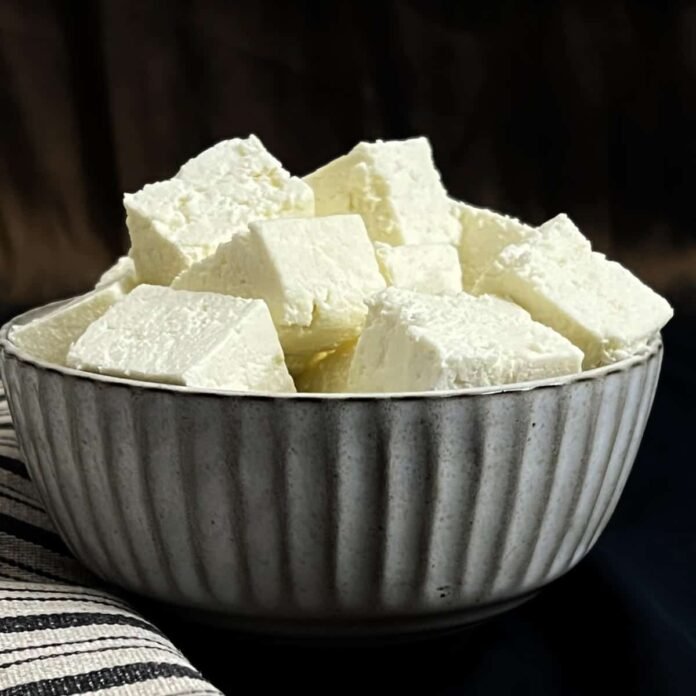Yogurt, lime, or vinegar: Which is the best ingredient for making paneer? Expert reveals lime as the quickest and most effective choice, significantly reducing the required time and adding a slight tangy taste that enhances its flavor. Making paneer at home remains straightforward, yet the variety of options can lead to decision fatigue. Should you prioritize health benefits and settle for a bland taste, or opt for a zingy option that adds flavor to your cottage cheese?
Paneer, a staple in Indian cuisine, is a versatile ingredient cherished for its mild taste and rich texture. Traditionally, it is made by curdling milk with an acidic substance, separating the curds from the whey. The choice of acidic agent plays a crucial role in determining the final taste and texture of paneer.
According to culinary experts, lime emerges as the top choice for preparing paneer due to its rapid curdling action. Lime juice, when added to boiling milk, swiftly coagulates the proteins, allowing the curds to form quickly. This method not only saves time but also imparts a subtle tanginess to the paneer, which enhances its overall flavor profile.
In contrast, yogurt and vinegar, while also effective in curdling milk, offer slightly different outcomes. Yogurt provides a milder flavor compared to lime, making it suitable for those who prefer a more neutral taste in their paneer. On the other hand, vinegar can give paneer a sharper tang, which some may find appealing for certain dishes.
The decision between these options often boils down to personal preference and the intended use of paneer in culinary preparations. Health-conscious individuals might lean towards yogurt for its probiotic benefits and lower acidity, despite the longer curdling time. Meanwhile, those seeking to elevate the flavor of their dishes may opt for lime or vinegar to impart a distinct taste to their homemade paneer.
For home cooks looking to experiment, the process of making paneer remains accessible regardless of the chosen acidic agent. By heating milk to a boil, adding the preferred acidic substance, and straining the resulting curds, anyone can achieve fresh, homemade paneer in no time. This simplicity encourages culinary exploration, allowing individuals to tailor their paneer to suit various recipes and personal tastes.
Yogurt, lime, or vinegar: Which is the best ingredient for making paneer? Experts emphasize lime as the quickest and most effective choice, significantly reducing the required time and adding a slight tangy taste that enhances its flavor. Making paneer at home remains straightforward, yet the variety of options can lead to decision fatigue. Should you prioritize health benefits and settle for a bland taste, or opt for a zingy option that adds flavor to your cottage cheese?
Paneer, a staple in Indian cuisine, is a versatile ingredient cherished for its mild taste and rich texture. Traditionally, it is made by curdling milk with an acidic substance, separating the curds from the whey. The choice of acidic agent plays a crucial role in determining the final taste and texture of paneer.
According to culinary experts, lime emerges as the top choice for preparing paneer due to its rapid curdling action. Lime juice, when added to boiling milk, swiftly coagulates the proteins, allowing the curds to form quickly. This method not only saves time but also imparts a subtle tanginess to the paneer, which enhances its overall flavor profile.
In contrast, yogurt and vinegar, while also effective in curdling milk, offer slightly different outcomes. Yogurt provides a milder flavor compared to lime, making it suitable for those who prefer a more neutral taste in their paneer. On the other hand, vinegar can give paneer a sharper tang, which some may find appealing for certain dishes.
The decision between these options often boils down to personal preference and the intended use of paneer in culinary preparations. Health-conscious individuals might lean towards yogurt for its probiotic benefits and lower acidity, despite the longer curdling time. Meanwhile, those seeking to elevate the flavor of their dishes may opt for lime or vinegar to impart a distinct taste to their homemade paneer.
For home cooks looking to experiment, the process of making paneer remains accessible regardless of the chosen acidic agent. By heating milk to a boil, adding the preferred acidic substance, and straining the resulting curds, anyone can achieve fresh, homemade paneer in no time. This simplicity encourages culinary exploration, allowing individuals to tailor their paneer to suit various recipes and personal tastes.
Ultimately, whether you choose yogurt, lime, or vinegar, each option offers a unique twist to the beloved paneer, transforming it from a simple ingredient into a versatile centerpiece of flavorful dishes. The choice rests in balancing convenience, flavor enhancement, and personal dietary preferences, ensuring that every homemade paneer creation is a delicious success.
Experimenting with paneer-making can also lead to discoveries in texture and consistency. The amount of acidity used affects how soft or firm the paneer turns out, influencing its suitability for different recipes. This versatility allows chefs to create paneer that ranges from soft and creamy for dishes like paneer tikka masala, to firmer varieties ideal for grilling or frying in dishes like paneer pakoras.
Furthermore, the nutritional benefits of paneer vary depending on the acidic agent chosen. Yogurt, for instance, not only aids in curdling but also adds protein and beneficial bacteria, contributing to a healthier option for homemade paneer. Lime and vinegar, while primarily used for their curdling properties, also add minimal calories and can enhance the flavor profile without compromising nutritional value.

